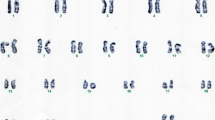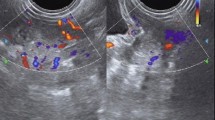Abstract
Ring chromosome 10—r(10)—is a rare disorder, with 14 cases reported in the literature, but only two with breakpoint determination by high-resolution techniques. We report here on two patients presenting a ring chromosome 10, studied by G-banding, fluorescent in situ hybridization (FISH), multiplex ligation-dependent probe amplification (MLPA) and SNP-array techniques, in order to investigate ring instability and determine breakpoints. Patient 1 showed a r(10)(p15.3q26.2) with a 7.9 Mb deletion in 10q26.2-q26.2, while patient 2 showed a r(10)(p15.3q26.13) with a 1.0 Mb deletion in 10p15.3 and a 8.8 Mb deletion in 10q26.13-q26.3, both unstable. While patient 1 presented with clinical features usually found in patients with r(10) and terminal 10q deletion, patient 2 presented characteristics so far not described in other patients with r(10), such as Dandy-Walker variant, osteopenia, semi-flexed legs, and dermal pigmentation regions. Our data and the data from literature show that there are no specific clinical findings to define a r(10) syndrome.


Similar content being viewed by others
References
Barber JCK, Temple IK, Campbell PL, Collinsion MN, Campbell CM, Renshaw RM, Dennis NR (1996) Unbalanced translocation in a mother and her son in one of two 5:10 translocation families. Am J Med Genet 62:84–90
Calabrese G, Franchi PG, Stuppia L, Mingarelli R, Rossi C, Ramenghi L, Marino M, Morizio E, Peila R, Antonucci A, Palka G (1994) A newborn with ring chromosome 10, aganglionic megacolon, and renal hypoplasia. J Med Genet 31:804–806
Christopoulou G, Tzetis M, Konstantinidou AE, Tsezou A, Kanavakis E, Kitsiou-Tzeli S, Velissariou V (2012) Clinical and molecular description of a fetus in prenatal diagnosis with a rare de novo ring 10 and deletions of 12.59 Mb in 10p15.3–p14 and 4.22 Mb in 10q26.3. Eur J Med Genet 55:75–79
Chung YP, Hwa HL, Tseng LH, Shyu MK, Lee CN, Shih JC, Hsieh FJ (1998) Prenatal diagnosis of monosomy 10q25 associated with single umbilical artery and sex reversal: report of a case. Prenat Diagn 18:73–77
Concolino D, Iembo MA, Moricca MT, Strisciuglio P, Marotta R, Rossi E, Giglio S (2003) Ring chromosome 10 (p15q26) in a patient with unipolar affective disorder, multiple minor anomalies, and mental retardation. Am J Med Genet 123A:201–203
Courtens W, Wuyts W, Rooms L, Pera SB, Wauters J (2006) A subterminal deletion of the long arm of chromosome 10: a clinical report and review. Am J Med Genet 140:402–409
ECARUCA (European Cytogeneticists Association Register of Unbalanced Chromosome Aberrations). Homepage http://umcecaruca01.extern.umcn.nl:8080/ecaruca/ecaruca.jsp [accessed November 23, 2012].
Enomoto H, Araki T, Jackman A, Heuckeroth RO, Snider WD, Johnson EM, Milbrandt J (1998) GFRα1-deficient mice have deficits in the enteric nervous system and kidneys. Neuron 21:317–324
Fryns P, De Boeck K, Jaken J, van den Berg H (1978) Malformative syndrome associated with a ring 10 chromosome and translocated 10q/19 chromosome. Hum Genet 43:239–244
Guilherme RS, Meloni VF, Kim CA, Pellegrino R, Takeno SS, Spinner NB, Conlin LK, Christofolini DM, Kulikowski LD, Melaragno MI (2011) Mechanisms of ring chromosome formation, ring instability and clinical consequences. BMC Med Genet 21;12:171
Gunnarsson C, Graffmann B, Jonasson J (2009) Chromosome r(10)(p15.3q26.12) in a newborn child: case report. Mol Cytogenet 2:1–6
Higashi K, Sarashina N, Okamoto T, Matsuki C, Heim S (1992) Supernumerary ring marker chromosome as a secondary rearrangement in a parapharyngeal lipoma with t(10;12)(q25;q15) as the primary karyotypic abnormality. Cancer Genet Cytogenet 64:163–165
Kishi K, Ikeuchi T, Yamamoto K, Tonomura A, Sakurada N, Satoh Y (1985) Report of a patient with a ring chromosome 10: mos45, XY,-10/46, XY/46, XY, r(10)(p15.3q26.3). Jinrui Idengaku Zasshi 30:233–238
Kondo I, Shimakura Y, Hirano T, Kaneko M, Yabuta K (1984) Ring chromosome 10 syndrome: case report and the possibility of clinical diagnosis. Clin Genet 25:196–200
Kosztolányi G (1987) Does “ring syndrome” exist? An analysis of 207 case reports on patients with a ring autosome. Hum Genet 75:174–179
Lansky S, Daniel W, Fleizar K (1977) Physical retardation associated with ring chromosome mosaicism: 46, XX, r(10)/45, XX,-10. J Med Genet 14:61–63
Larson LM, Wasdahl WA, Saumur JH, Coleman ML, Hall JG, Dolan CR, Schutta CJ (1982) Familial reciprocal translocation, t(2;10)(p24;q26), resulting in duplication 2p and deletion 10q. Clin Genet 21:187–195
Michels VV, Driscoll DJ, Ledbetter DH, Riccardi VM (1981) Phenotype associated with ring 10 chromosome: report of patient and review of literature. Am J Med Genet 9:231–237
Miyamoto N, Yoshida M, Kuratani S, Matsuo I, Aizawa S (1997) Defects of urogenital development in mice lacking Emx2. Development 124:1653–1664
Moschonas NK, Spurr NK, Mao J (1996) Report of the first international workshop on human chromosome 10 mapping. Cytogenetic Cell Genet 73:99–112
Nakai H, Adachi M, Katsushima N, Yamazaki N, Sakamoto M, Tada K (1983) Ring chromosome 10 and its clinical features. J Med Genet 20:142–144
Ogata T, Muroya K, Sasagawa I, Kosho T, Wakui K, Sakazume S, Ito K, Matsuo N, Ohashi H, Nagai T (2000) Genetic evidence for a novel gene(s) involved in urogenital development on 10q26. Kidney Int 58:2281–2290
Resta RG, Luthardt F, Kapur R (1996) Follow-up of a familial translocation t(6;10) with an unbalanced segregation pattern. Am J Med Genet 63:363–365
Schinzel A (2001) Catalogue of unbalanced chromosome aberrations in man, 2nd edn. Walter de Gruyter, Berlin
Schuchardt A, D’Agati V, Larsson-Blomberg L, Costantini F, Pachnis V (1994) Defects in the kidney and enteric nervous system of mice lacking the tyrosine kinase receptor. Ret Nature 367:380–383
Serville F, Briault R, Taillemite JL, Despoisse S, Cotoni P, Broustet A (1982) Ring chromosome 10: 46, XX, r(10)(p15q26). Ann Genet 25:168–171
Shapiro SD, Hansen KL, Pasztor LM, DiLiberti JH, Jorgenson RJ, Young RS, Moore CM (1985) Deletions of the long arm of chromosome 10. Am J Med Genet 20:181–196
Simoni G, Rossella F, Dalpra L, Visconi G, Piria-Schwaz C (1979) Ring chromosome 10 associated with multiple congenital malformations. Hum Genet 51:117–121
Sparkes RS, Ling SM, Muller H (1978) Ring 10 chromosome: 46, XX, r(10)(p15q26). Hum Genet 43:341–345
Torres M, Gómez-Pardo E, Dressler GR, Gruss P (1995) Pax-2 controls multiple steps of urogenital development. Development 121:4057–4065
Tsukino R, Tsuda N, Dezawa T, Ishii T, Koike M (1980) Ring chromosome 10: 46, XX, r(10)(p15q26). J Med Genet 17:148–150
Waggoner DJ, Chow CK, Dowton SB, Watson MS (1999) Partial monosomy of distal 10q: three new cases and a review. Am J Med Genet 3:1–5
Wilkie AOM, Cambell FM, Daubeney P, Grant DB, Daniels RJ, Millarkey M, Affar NA, Fitchett M, Huson SM (1993) Complete and partial XY sex reversal associated with terminal deletion of 10q: report of 2 cases and literature review. Am J Med Genet 46:597–600
Yatsenko SA, Kruer MC, Bader PI, Corzo D, Schuette J, Keegan CE, Nowakowska B, Peacock S, Cai WW, Peiffer DA, Gunderson KL, Ou Z, Chinault AC, Cheung SW (2009) Identification of critical regions for clinical features of distal 10q deletion syndrome. Clin Genet 76:54–62
Zollino M, Seminara L, Orteschi D, Gobbi G, Giovannini S, Giustina ED, Frattini D, Scarano A, Neri G (2009) The ring 14 syndrome: clinical and molecular definition. Am J Med Genet 149A:1116–1124
Zorn E (1984) Chromosome-10 defects in two newborn infants. Hosp Pract 19:34I–34J, 34O–34P
Acknowledgments
This work was supported by FAPESP, Brazil (Grant to MIM).
Author information
Authors and Affiliations
Corresponding author
Rights and permissions
About this article
Cite this article
Guilherme, R.S., Kim, C.A., Alonso, L.G. et al. Ring chromosome 10: report on two patients and review of the literature. J Appl Genetics 54, 35–41 (2013). https://doi.org/10.1007/s13353-012-0128-7
Received:
Revised:
Accepted:
Published:
Issue Date:
DOI: https://doi.org/10.1007/s13353-012-0128-7




